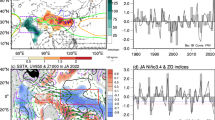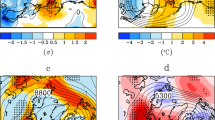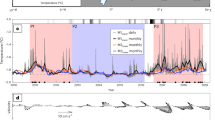Abstract
Alaskan Arctic waters have participated in hemispheric-wide Arctic warming over the last two decades at over two times the rate of global warming. During 2008–13, this relative warming occurred only north of the Bering Strait and the atmospheric Arctic front that forms a north–south thermal barrier. This front separates the southeastern Bering Sea temperatures from Arctic air masses. Model projections show that future temperatures in the Chukchi and Beaufort seas continue to warm at a rate greater than the global rate, reaching a change of +4°C by 2040 relative to the 1981–2010 mean. Offshore at 74°N, climate models project the open water duration season to increase from a current average of three months to five months by 2040. These rates are occasionally enhanced by midlatitude connections. Beginning in August 2014, additional Arctic warming was initiated due to increased SST anomalies in the North Pacific and associated shifts to southerly winds over Alaska, especially in winter 2015–16. While global warming and equatorial teleconnections are implicated in North Pacific SSTs, the ending of the 2014–16 North Pacific warm event demonstrates the importance of internal, chaotic atmospheric natural variability on weather conditions in any given year. Impacts from global warming on Alaskan Arctic temperature increases and sea-ice and snow loss, with occasional North Pacific support, are projected to continue to propagate through the marine ecosystem in the foreseeable future. The ecological and societal consequences of such changes show a radical departure from the current Arctic environment.
摘要
过去二十年来, 阿拉斯加北极海域参与了北极半球尺度的增暖, 其增暖速率达到了全球增暖速率的两倍多. 在2008年至2013年期间, 这种相对增暖主要发生在白令海峡和形成南北热力屏障的北极锋区以北. 这一锋区将东南部的白令海温度与北极气团分隔开. 数值模式的预测结果表明, 楚科奇海和博福特海未来将继续以高于全球速率的水平增暖. 到2040年, 该地区的温度相对于1981-2010年的平均值将高出 4°C. 气候模式还预测, 在74°N海面上的开放水域持续时间将从目前的平均3个月增加到2040年的5个月. 这些增速有时会因中纬度的相关而增强. 从2014年8月开始, 北极增暖的进一步加剧始于北太平洋的海面温度(SST)异常增暖, 并伴随着阿拉斯加上方相应转变的南风导致, 特别是2015-16年冬季. 虽然全球增暖和赤道遥相关主要影响北太平洋海温, 但2014-16北太平洋增暖事件的结束表明了在任何一年混沌的大气内部自然变率对天气的重要性. 在可预见的未来, 伴随着北太平洋偶尔的支持, 全球变暖对阿拉斯加的温度增加和北极海冰和积雪减少的影响将继续通过海洋生态系统传播. 这种变化的生态和社会后果将显示出与当前北极环境的根本偏离.
Similar content being viewed by others
References
Ballinger, T. J., and S. C. Sheridan, 2014: Associations between circulation pattern frequencies and sea ice minima in the western Arctic. International Journal of Climatology, 34, 1385–1394, https://doi.org/10.1002/joc.3767.
Ballinger, T. J., and J. C. Rogers, 2014: Climatic and atmospheric teleconnection indices and western Arctic sea ice variability. Physical Geography, 35, 459–477, https://doi.org/10.1080/02723646.2014.949338.
Ballinger, T. J., S. C. Sheridan, and E. Hanna, 2014: Resolving the Beaufort Sea High using synoptic climatological methods. International Journal of Climatology, 34, 3312–3319, https://doi.org/10.1002/joc.3907.
Baxter, S., and S. Nigam, 2015: Key role of the North Pacific Oscillation-West Pacific Pattern in generating the extreme 2013/14 North American winter. J. Climate, 28, 8109–8117, https://doi.org/10.1175/JCLI-D-14-00726.1.
Belleflamme, A., X. Fettweis, and M. Erpicum, 2015: Recent summer Arctic atmospheric circulation anomalies in a historical perspective. The Cryosphere, 9, 53–64, https://doi.org/10.5194/tc-9-53-2015.
Bezeau, P., M. Sharp, and G. Gascon, 2015: Variability in summer anticyclonic circulation over the Canadian Arctic Archipelago and west Greenland in the late 20th/early 21st centuries and its effect on glacier mass balance. International Journal of Climatology, 35, 540–557, https://doi.org/10.1002/joc.4000.
Bond, N. A., and D. E. Harrison, 2006: ENSO’s effect on Alaska during opposite phases of the Arctic Oscillation. International Journal of Climatology, 26, 1821–1841, https://doi.org/10.1002/joc.1339.
Bond, N. A., M. F. Cronin, H. Freeland, and N. Mantua, 2015: Causes and impacts of the 2014 warm anomaly in the NE Pacific. Geophys. Res. Lett., 42, 3414–3420, https://doi.org/10.1002/2015GL063306.
Cassano, E. N., J. M. Glisan, J. J. Cassano, W. J. Gutowski Jr., and M. W. Seefeldt, 2015: Self-organizing map analysis of widespread temperature extremes in Alaska and Canada. Climate Research, 62, 199–218, https://doi.org/10.3354/cr01274.
Holland, M. M., and C. M. Bitz, 2003: Polar amplification of climate change in coupled models. Climate Dyn., 21, 221–232, https://doi.org/10.1007/s00382-003-0332-6.
IPCC, 2013: Climate Change 2013: The Physical Science Basis. Contribution of Working Group I to the Fifth Assessment Report of the Intergovernmental Panel on Climate Change [Stocker, T.F., D. Qin, G.-K. Plattner, M. Tignor, S.K. Allen, J. Boschung, A. Nauels, Y. Xia, V. Bex and P.M. Midgley (eds.)]. Cambridge University Press, Cambridge, United Kingdom and New York, NY, USA, 1535 pp.
Liu, J. P., J. A. Curry, and Y. Y. Hu, 2004: Recent Arctic sea ice variability: Connections to the Arctic Oscillation and the ENSO. Geophys. Res. Lett., 31, L09211, https://doi.org/10.1029/2004GL019858.
Makshtas, A. P., I. I. Bolshakova, R. M. Gun, O. L. Jukova, N. E. Ivanov, and S. V. Shutilin, 2011: Climate of the hydrometeorological observatory Tiksi region. Meteorological and Geophysical Investigations, M. Paulsen, Ed., 49–74.
Newman, M., and Coauthors, 2016: The Pacific decadal oscillation, revisited. J. Climate, 29, 4399–4427, https://doi.org/10.1175/JCLI-D-15-0508.1.
Overland, J. E., and M. Y. Wang, 2005: The third Arctic climate pattern: 1930s and early 2000s. Geophys. Res. Lett., 32, L23808, https://doi.org/10.1029/2005GL024254.
Overland, J. E., D. B. Percival, and H. O. Mofjeld, 2006: Regime shifts and red noise in the North Pacific. Deep Sea Research Part I, 53, 582–588, https://doi.org/10.1016/j.dsr.2005.12.011.
Overland, J. E., J. A. Francis, E. Hanna, and M. Y. Wang, 2012: The recent shift in early summer arctic atmospheric circulation. Geophys. Res. Lett., 39, L19804, https://doi.org/10.1029/2012GL053268.
Overland, J. E., J. Wang, R. S. Pickart, and M. Y. Wang, 2014a: Recent and future changes in the meteorology of the Pacific Arctic. The Pacific Arctic Region, J. Grebmeier and W. Maslowski, Eds., Springer, Dordrecht, 17–30, https://doi.org/10.1007/978-94-017-8863-22.
Overland, J. E., M. Y. Wang, J. E. Walsh, and J. C. Stroeve, 2014b: Future Arctic climate changes: Adaptation and mitigation time scales. Earth’s Future, 2, 68–74, https://doi.org/10.1002/2013EF000162.
Papineau, J. M., 2001: Wintertime temperature anomalies in Alaska correlated with ENSO and PDO. International Journal of Climatology, 21, 1577–1592, https://doi.org/10.1002/joc.686.
Petrie, R. E., L. C. Shaffrey, and R. T. Sutton, 2015: Atmospheric response in summer linked to recent Arctic sea ice loss. Quart. J. Roy. Meteor. Soc., 141, 2070–2076, https://doi.org/10.1002/qj.2502.
Pithan, F., and T. Mauritsen, 2014: Arctic amplification dominated by temperature feedbacks in contemporary climate models. Nature Geoscience, 7, 181–184, https://doi.org/10.1038/ngeo2071.
Serreze, M. C., and R. G. Barry, 2011: Processes and impacts of Arctic amplification: A research synthesis. Global and Planetary Change, 77, 85–96, https://doi.org/10.1016/j.gloplacha.2011.03.004.
Stroeve, J. C., M. C. Serreze, M. M. Holland, J. E. Kay, J. Maslanik, and A. P. Barrett, 2012: The Arctic’s rapidly shrinking sea ice cover: A research synthesis. Climatic Change, 110, 1005–1027, https://doi.org/10.1007/s10584-011-0101-1.
Walsh, J., P. A. Bieniek, B. Brettschneider, E. S. Euskirchen, R. Lader, and R. L. Thoman, 2017: The exceptionally warm winter of 2015/16 in Alaska. J. Climate, 30, 2069–2088, https://doi.org/10.1175/JCLI-D-16-0473.1.
Wang, J., J. L. Zhang, E. Watanabe, M. Ikeda, K. Mizobata, J. E. Walsh, X. Z. Bai, and B. Y. Wu, 2009: Is the Dipole Anomaly a major driver to record lows in Arctic summer sea ice extent? Geophys. Res. Lett., 36, L05706, https://doi.org/10.1029/2008GL036706.
Wang, J., and Coauthors, 2014: Abrupt climate changes and emerging ice-ocean processes in the Pacific Arctic region and the Bering Sea. The Pacific Arctic Region, J. Grebmeier and W. Maslowski, Eds., Springer, 65–99, https://doi.org/10.1007/978-94-017-8863-24.
Wang, M. Y., and J. E. Overland, 2015: Projected future duration of the sea-ice-free season in the Alaskan Arctic. Progress in Oceanography, 136, 50–59, https://doi.org/10.1016/j.pocean.2015.01.001.
Wang, M., Q. Yang, J. E. Overland, and P. Stabeno, 2017: Seaice Evolution in the Pacific Arctic: the present to mid-century by selected CMIP5 models. Deep Sea Research Part II. (in press).
Wassmann, P., 2015: Overarching perspectives of contemporary and future ecosystems in the Arctic Ocean. Progress in Oceanography, 139, 1–12, https://doi.org/10.1016/j.pocean.2015.08.004.
Wood, K. R., J. E. Overland, S. A. Salo, N. A. Bond, W. J. Williams, and X. Q. Dong, 2013: Is there a “new normal” climate in the Beaufort Sea? Polar Research, 32, 19552, https://doi.org/10.3402/polar.v32i0.19552.
Wu, B. Y., J. Wang, and J. E. Walsh, 2006: Dipole anomaly in the winter arctic atmosphere and its association with sea ice motion. J. Climate, 19, 210–225, https://doi.org/10.1175/JCLI3619.1.
Zhang, L. P., and T. L. Delworth, 2015: Analysis of the characteristics and mechanisms of the pacific decadal oscillation in a suite of coupled models from the geophysical fluid dynamics laboratory. J. Climate, 28, 7678–7701, https://doi.org/10.1175/JCLI-D-14-00647.1.
Acknowledgements
The work was supported by the NOAA Arctic Research Project of the Climate Program Office. Data fields from the NCEP–NCAR Reanalysis are available as images provided by the NOAA/ESRL Physical Sciences Division, Boulder, Colorado from their website at http://www.esrl.noaa.gov/psd/. This publication was partially funded by the Joint Institute for the Study of the Atmosphere and Ocean (JISAO) under the NOAA Cooperative Agreement NA10OAR4320148, contribution number 2016-01-40. PMEL contribution number: 4535.
Author information
Authors and Affiliations
Corresponding author
Rights and permissions
About this article
Cite this article
Overland, J.E., Wang, M. & Ballinger, T.J. Recent increased warming of the Alaskan marine Arctic due to midlatitude linkages. Adv. Atmos. Sci. 35, 75–84 (2018). https://doi.org/10.1007/s00376-017-7026-1
Received:
Revised:
Accepted:
Published:
Issue Date:
DOI: https://doi.org/10.1007/s00376-017-7026-1




